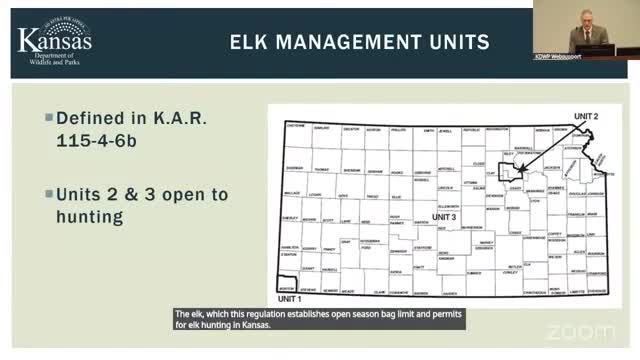Kansas increases elk hunt permits near Fort Riley to manage growing herds
March 27, 2025 | Department of Wildlife & Parks, State Agencies, Organizations, Executive, Kansas
Thanks to Scribe from Workplace AI , all articles about Kansas are free for you to enjoy throughout 2025!

This article was created by AI using a video recording of the meeting. It summarizes the key points discussed, but for full details and context, please refer to the video of the full meeting. Link to Full Meeting
One of the key topics was the management of elk hunting units, particularly Units 2 and 3. Unit 2, which includes Fort Riley, has been designated for elk hunting while ensuring a buffer zone to prevent hunting near military operations. The meeting revealed that the elk population in this area has been stable, prompting the KDWP to propose an increase in hunting permits. Specifically, the commission suggested raising the number of available permits to 15 for any elk and 24 for antlerless elk in Unit 2. This change reflects a growing concern over potential damage caused by elk herds in the vicinity of Fort Riley, as the population has been thriving in recent years.
The commission also discussed the broader implications of elk management across Kansas. Currently, the only area closed to elk hunting is a part of Morton County, which encompasses Cimarron National Grasslands. The KDWP aims to maintain a balance between elk population growth and agricultural interests, as unchecked elk populations can lead to significant crop damage. The strategy moving forward involves allowing liberal hunting opportunities to manage elk numbers effectively while encouraging landowners to take an active role in protecting the species on their properties.
In addition to elk management, the meeting touched on deer permit quotas, with a correction noted for the upcoming season dates. The KDWP is committed to ensuring that hunting regulations remain effective and responsive to wildlife populations and landowner concerns.
Overall, the KDWP's discussions during this meeting underscore the importance of sustainable wildlife management practices in Kansas. The proposed changes to elk hunting regulations aim to address both ecological balance and agricultural protection, reflecting the department's ongoing efforts to adapt to changing wildlife dynamics. The commission's decisions will move into the promulgation process, with further public input anticipated as the regulations are finalized.
Converted from KDWP Commission Meeting - Thursday, March 27, 2025 meeting on March 27, 2025
Link to Full Meeting
Comments
View full meeting
This article is based on a recent meeting—watch the full video and explore the complete transcript for deeper insights into the discussion.
View full meeting
